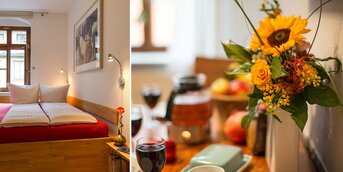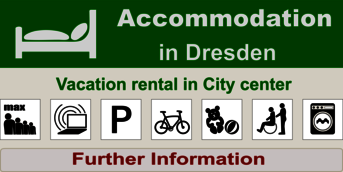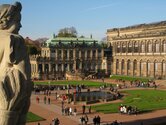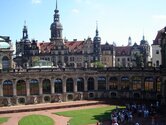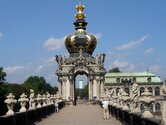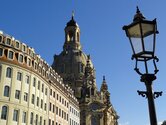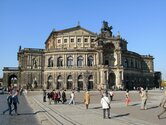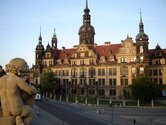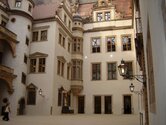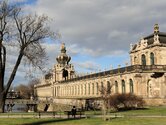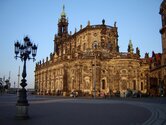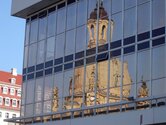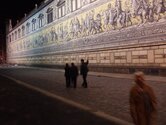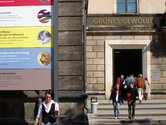Don't miss these places - tourist highlights in Dresden
Especially for visitors, who are in town for the first time, and for daily visitors, who are on the spur of the moment, the following sights are a must. All are close together and on the way in between there is even more to explore to the left and right.
Zwinger Palace
Beginning from 1709 this world famous baroque synthesis of the arts of architecture, sculpture and painting was constructed under the direction of the architect Matthäus Daniel Pöppelmann (1662 - 1736) and the sculptor Balthasar Permoser (1651 – 1732) by order of the Saxon elector August the Strong (1670 – 1733). Started as an orangery the Zwinger Palace soon evolved into an excellent site of courtly culture of festivals and representation of August the Strong. Today you can find museums in the Zwinger Palace: New Masters Gallery and Porcelain Collection.
Semper Opera House
It is one of the most beautiful opera houses of the world! The Semper Opera Ball/Dresden Opera Ball (Semperopernball) takes place for just two years but is nothing short of the Vienna Opera Ball. After the first Semper Opera House had been destroyed by a fire, the second building arose between 1871 and 1878. Destroyed again in the bombing of February 1945 the house was opened in present shape 40 years later with the opera “The Marksman”/“The Freeshooter” (“Der Freischütz”) by Carl Maria von Weber (1786 – 1826). The Dresden Ballet, the Chorus of the State Opera House, and the world famous Saxon State Orchestra Dresden have their place of activity here. Sightseeing is offered nearly everyday.
Royal Palace Dresden
The Royal Palace Dresden is one of the most important examples of Renaissance architecture in Germany. Over more than seven centuries it was the residence of the Electors and Kings of Saxony from the House of Wettin. As the oldest building of Dresden it originates in a mediaeval castle, which was extended in the fifteenth century and became a castle with four wings. In the sixteenth century an extension in the Renaissance style was added and in the nineteenth century again it took its current shape in the neo-Renaissance style. Today you can find several museums in the castle: Green Vault (Grünes Gewölbe), Armoury, Copperplate Engraving Cabinet (Kupferstichkabinett), the Coin Cabinet (Muenzkabinet) and the Art Library (Kunstbibliothek).
Green Vault
In September 2006, August the Strong’s world-famous treasure chamber has been reopened in the Dresden Royal Palace. 75% of the Time Tickets for admission are booked in advance. A “Time Ticket” specifies the time slot in which its holder can visit the exhibition. The Time Ticket system is being introduced as a means of preventing long queues and waiting times. You can determine the time of your visit when you book your ticket. Tickets can be booked online or by phone +49 (0)351 49 14 2000 and payment made by credit card or bank transfer.
Catholic Hoflirche church
As August the Strong (1670 – 1733) had converted to the Catholic religion in order to became King of Poland, it was necessary to establish a sign of religious importance in the since 1539 Protestant Dresden. Thus he ordered the building of the Hofkirche. The church was consecrated in 1751. After nearly 40 years of reconstruction, to remedy the defects of war, today you can experience the church as a brightly decorated jewel of the historical city centre of Dresden. The square in front of the Semper Opera House at the Catholic Court Church is a popular spot for day tourists - short trip.
The Fürstenzug (Procession of the Princes) – the Saxon sovereigns
Since 1876 the Fürstenzug has decorated the outside facade in the Augustusstraße. With its length of 102 metres and a surface of 957 square metres it is the world’s largest porcelain picture. It reveals an original chronicle of the House of Wettin with 35 Saxon margraves, duke, electors and kings, who reigned between 1123 and 1904, and 58 further persons.
Church of Our Lady (Frauenkirche)
At one time financed by the Dresden citizenry the Frauenkirche, the masterpiece of George Bähr (1666 - 1738), was built between 1728 and 1743 beside the long in a ruinous condition old Frauenkirche as a 91 metres high baroque central-plan building with a boldly towering sandstone dome (diameter of 23.50 metres). An initiative, for reconstruction of the Frauenkirche succeeded by a worldwide appeal for funds to collect benefits totalling 180 million Euros. Work began on 27th May 1994 and the crypt could be consecrated already in August 1996. On 30th October 2005 the time had come. 60.000 people of Dresden and guests from all over the world gathered together on Neumarkt to witness the consecration service on the ground. The church is varied venue, centre of attraction for guests of the town par excellence, and from the tower a glorious view over Dresden and the Elbe Valley Basin (Elbtal) is offered. From October 2005 through the year 2010, there is an exhibition on the history and the reconstruction of the Frauenkirche shown in the City Museum (Städtische Galerie Dresden) in the Landhaus at Pirnaischer Platz.

